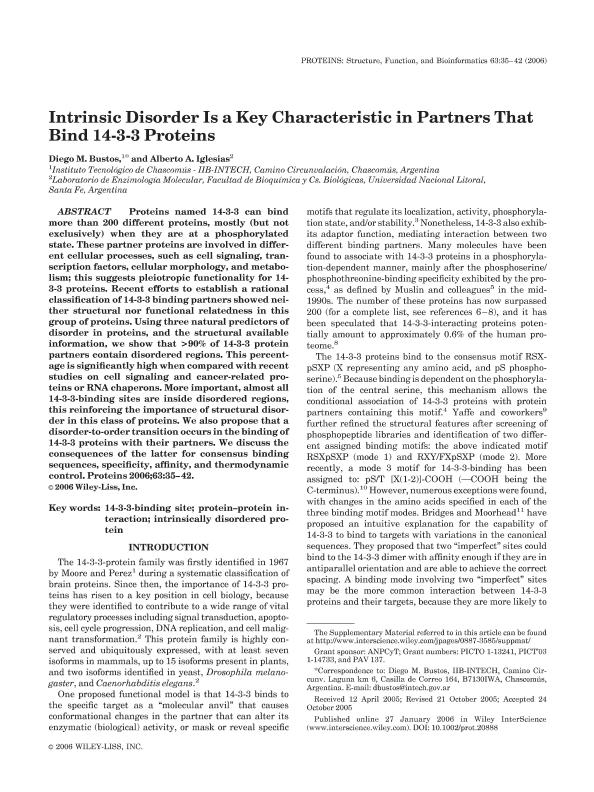Mostrar el registro sencillo del ítem
dc.contributor.author
Bustos, Diego Martin

dc.contributor.author
Iglesias, Alberto Alvaro

dc.date.available
2019-12-27T03:13:35Z
dc.date.issued
2006-04
dc.identifier.citation
Bustos, Diego Martin; Iglesias, Alberto Alvaro; Intrinsic disorder is a key characteristic in partners that bind 14-3-3 proteins; Wiley-liss, Div John Wiley & Sons Inc; Proteins: Structure, Function And Genetics; 63; 1; 4-2006; 35-42
dc.identifier.issn
0887-3585
dc.identifier.uri
http://hdl.handle.net/11336/93022
dc.description.abstract
Proteins named 14-3-3 can bind more than 200 different proteins, mostly (but not exclusively) when they are at a phosphorylated state. These partner proteins are involved in different cellular processes, such as cell signaling, transcription factors, cellular morphology, and metabolism; this suggests pleiotropic functionality for 14-3-3 proteins. Recent efforts to establish a rational classification of 14-3-3 binding partners showed neither structural nor functional relatedness in this group of proteins. Using three natural predictors of disorder in proteins, and the structural available information, we show that >90% of 14-3-3 protein partners contain disordered regions. This percentage is significantly high when compared with recent studies on cell signaling and cancer-related proteins or RNA chaperons. More important, almost all 14-3-3-binding sites are inside disordered regions, this reinforcing the importance of structural disorder in this class of proteins. We also propose that a disorder-to-order transition occurs in the binding of 14-3-3 proteins with their partners. We discuss the consequences of the latter for consensus binding sequences, specificity, affinity, and thermodynamic control.
dc.format
application/pdf
dc.language.iso
eng
dc.publisher
Wiley-liss, Div John Wiley & Sons Inc

dc.rights
info:eu-repo/semantics/openAccess
dc.rights.uri
https://creativecommons.org/licenses/by-nc-sa/2.5/ar/
dc.subject
14-3-3-BINDING SITE
dc.subject
INTRINSICALLY DISORDERED PROTEIN
dc.subject
PROTEIN-PROTEIN INTERACTION
dc.subject.classification
Bioquímica y Biología Molecular

dc.subject.classification
Ciencias Biológicas

dc.subject.classification
CIENCIAS NATURALES Y EXACTAS

dc.title
Intrinsic disorder is a key characteristic in partners that bind 14-3-3 proteins
dc.type
info:eu-repo/semantics/article
dc.type
info:ar-repo/semantics/artículo
dc.type
info:eu-repo/semantics/publishedVersion
dc.date.updated
2019-09-27T14:17:31Z
dc.journal.volume
63
dc.journal.number
1
dc.journal.pagination
35-42
dc.journal.pais
Estados Unidos

dc.journal.ciudad
Nueva York
dc.description.fil
Fil: Bustos, Diego Martin. Consejo Nacional de Investigaciones Científicas y Técnicas. Centro Científico Tecnológico Conicet - La Plata. Instituto de Investigaciones Biotecnológicas. Instituto de Investigaciones Biotecnológicas "Dr. Raúl Alfonsín" (sede Chascomús). Universidad Nacional de San Martín. Instituto de Investigaciones Biotecnológicas. Instituto de Investigaciones Biotecnológicas "Dr. Raúl Alfonsín" (sede Chascomús); Argentina
dc.description.fil
Fil: Iglesias, Alberto Alvaro. Consejo Nacional de Investigaciones Científicas y Técnicas; Argentina. Universidad Nacional del Litoral. Facultad de Bioquímica y Ciencias Biológicas. Laboratorio de Enzimología Molecular; Argentina
dc.journal.title
Proteins: Structure, Function And Genetics

dc.relation.alternativeid
info:eu-repo/semantics/altIdentifier/doi/http://dx.doi.org/10.1002/prot.20888
dc.relation.alternativeid
info:eu-repo/semantics/altIdentifier/url/https://onlinelibrary.wiley.com/doi/abs/10.1002/prot.20888
Archivos asociados
